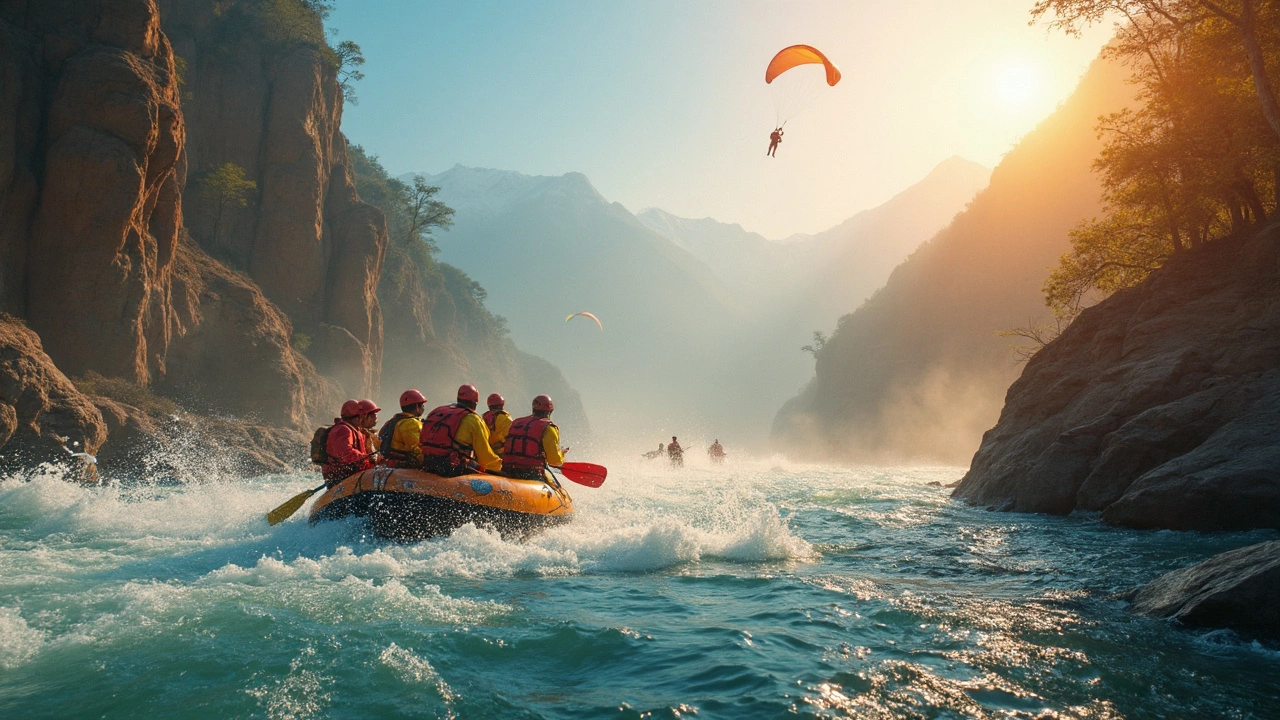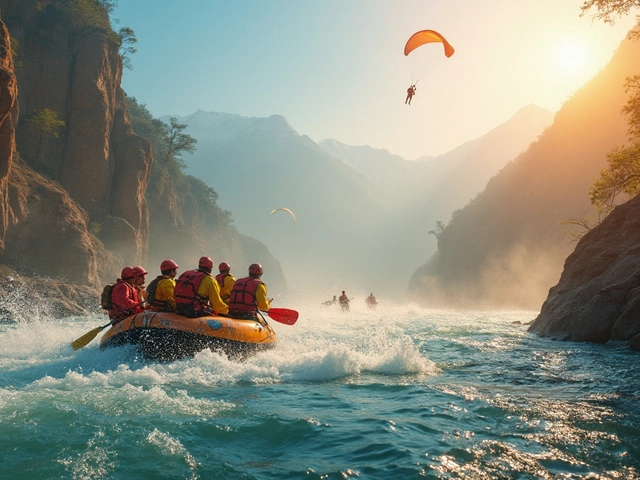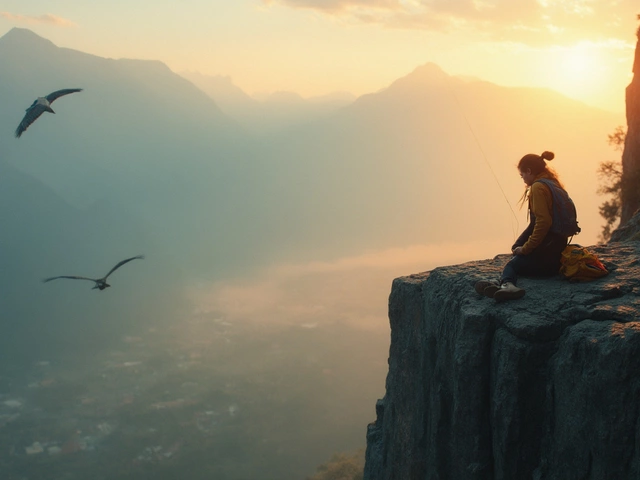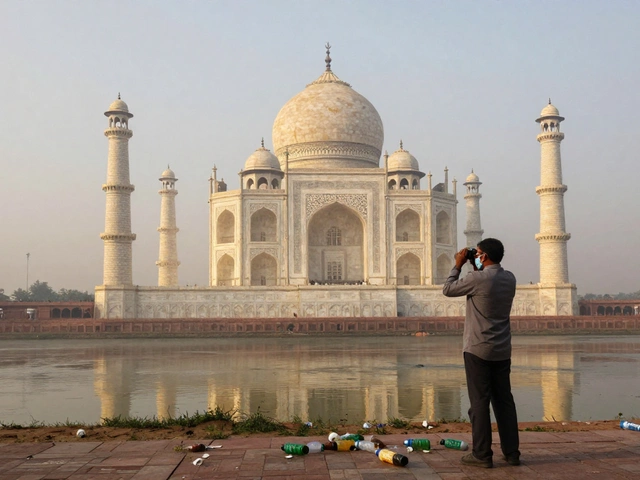Not all sports crank your heart rate to max and make you feel unstoppable, but adventure sports are wired just for that. In India, the choices seem endless—rushing rivers, wild mountain drops, and sky-high flights all compete for your attention. So what actually counts as the ‘most adventurous’ sport here?
If you think it’s just about danger, think again. Adventure is about the wild unknown, overcoming nerves, and pushing past what you thought you could handle. It’s what makes people leap off cliffs in Bir Billing, paddle raging rapids in Rishikesh, or trek icy slopes in Ladakh.
Here’s the real deal: With so many options, the top sport isn’t just about being risky, but about how much it pulls you out of your comfort zone. From the stories shared by those hooked on adventure to the numbers on safety gear sales in Manali, there’s a pattern—Indians love leveling up the thrill factor.
- What Makes a Sport Truly Adventurous?
- The Contenders: India's Wildest Adventure Sports
- The Case for White Water Rafting
- Why Paragliding Turns Heads
- Beyond the Usual: Unheard-of Thrills
- Tips to Stay Safe and Amp Up the Fun
What Makes a Sport Truly Adventurous?
When you hear “adventurous sport,” most folks picture something intense—like standing on a narrow ledge before a bungee jump or paddling for your life down choppy rapids. But what really decides if a sport deserves that label? It’s not just about the level of risk. It’s about stepping up to the unknown, and that feeling of ‘I-can’t-believe-I-just-did-that’ after you’re done.
- Challenge Factor: The more a sport pushes your body and mind, the more adventurous it feels. Think about river rafting in the Ganges. It’s not just how rough the water gets, but how you tackle that unpredictability with your crew.
- Skill and Preparation: Some of India’s top adventure sports need both natural guts and serious prep. For example, learning paragliding basics or rafting techniques takes actual training, sometimes with certified instructors.
- The Environment: Location changes everything. Jumping off a platform in Goa isn’t the same as flying over snowy Bir Billing. The place itself can turn a regular activity into an epic story.
- The Risk: Let’s be honest—there’s always a little risk. But with the right guides and safety measures, these sports become accessible. National adventure tourism stats show about 2 lakh (200,000) people tried adventure sports in India during 2024, and the majority picked up only minor bumps or scrapes. The odds are in your favor if you stay smart.
Here’s a quick look at common features in India’s most adventurous sports:
| Feature | Why It Matters |
|---|---|
| High adrenaline | Keeps you alert and excited |
| Rapid decision-making | Tests your nerves in real time |
| Physical demand | Makes you push personal limits |
| Unpredictable settings | Never two experiences are the same |
If you're after the most adventurous experience, don’t just look for danger. Go after the sport that flips your comfort zone upside down and leaves you with a story to tell.
The Contenders: India's Wildest Adventure Sports
If you ever wanted an adrenaline rush, India really is a playground loaded with wild choices. It's not just about mountains or rivers—there’s something for everyone who’s itching to push their limits. These are the sports that regularly top the charts and send heart rates through the roof.
- White Water Rafting: Rishikesh is practically a rite of passage for thrill-seekers. The rapids here are so famous that over 30,000 people raft the Ganga every year, with Grade III and IV stretches that keep even pros on their toes.
- Paragliding: Bir Billing in Himachal Pradesh is a world hotspot—literally ranked among the top flying sites worldwide. People from more than 50 countries show up every season for the take-off at 8,000 ft and those crazy long flights.
- Bungee Jumping: Rishikesh does it again, claiming the country’s highest bungee at a whopping 83 meters. Not for the faint-hearted, but every year, it sees 20,000+ daredevils take the leap.
- Rock Climbing: Hampi and Badami are the go-to places. Hampi headlines as a global bouldering hub, where climbers tackle 1000s of granite rocks. Even absolute beginners get hooked fast here because the routes are so varied.
- Scuba Diving: The Andaman Islands offer crystal-clear water and shipwrecks to explore. Havelock Island reports more than 10,000 dives every season—perfect for spotting turtles, barracudas, and sometimes, elusive manta rays.
If you're wondering which activity gets the most buzz or draws the largest crowds, check out these real numbers:
| Adventure Sport | Top Location | Avg. Annual Participants | Thrill Factor (1-5) |
|---|---|---|---|
| White Water Rafting | Rishikesh | 30,000+ | 5 |
| Paragliding | Bir Billing | 15,000+ | 4 |
| Bungee Jumping | Rishikesh | 20,000+ | 5 |
| Rock Climbing | Hampi | 8,000+ | 4 |
| Scuba Diving | Havelock Island | 10,000+ | 3 |
Clearly, the adventure sports India scene is loaded with options that keep things fresh and exciting. Each sport brings its own style of risk, scenery, and crowd, so it’s all about the kind of thrill you’re after.
The Case for White Water Rafting
If you're looking for a sport that blends fear, fun, and pure adrenaline, it’s hard to ignore white water rafting. This is the one adventure almost everyone dares to try at least once in India, especially on the Ganga’s rapids at Rishikesh. The thrill isn’t just hype—it’s real, and it’s measured. Rafting on Grade III and IV rapids means dealing with drops, rocks, and sudden swells that demand teamwork and nerves of steel.
Why is it so popular? Besides being ridiculously exciting, it feels accessible. You don’t need years of training to hop into a raft. A short briefing, a decent life jacket, and you’re in action, led by an experienced river guide. Still, the adventure level is high enough that even regulars admit to getting the jitters before the first big rapid.
The places where you can go white water rafting in India are legendary. Rishikesh, Teesta in Sikkim, the Indus in Ladakh—each has its own flavor. In Rishikesh alone, the annual rafting season (usually September to June) draws an estimated 70,000 thrill-seekers. Check out some key facts and the best rafting spots:
| River | Region | Difficulty Level | Season |
|---|---|---|---|
| Ganga | Rishikesh, Uttarakhand | Easy to Advanced (Grade I-IV) | Sept-June |
| Teesta | Sikkim | Moderate (Grade II-III) | Oct-April |
| Indus | Ladakh | Challenging (Grade III-IV) | June-Aug |
Now, let’s talk safety, because that’s what actually decides whether you end up with a killer story or a disaster. The good news? Most operators stick to global safety protocols. Always wear proper gear, listen to your guide (even if you think those last-minute tips aren’t needed), and never jump in alone.
- Go with certified guides only—they know the river inside out.
- Double-check your gear for fit and quality.
- Never drink alcohol before hitting the water.
And, if you’re here for the stats, the adventure sports India scene records very few major accidents when safety measures are followed. It’s the sweet spot—crazy wild fun, while still staying safe if you keep your head in the game.
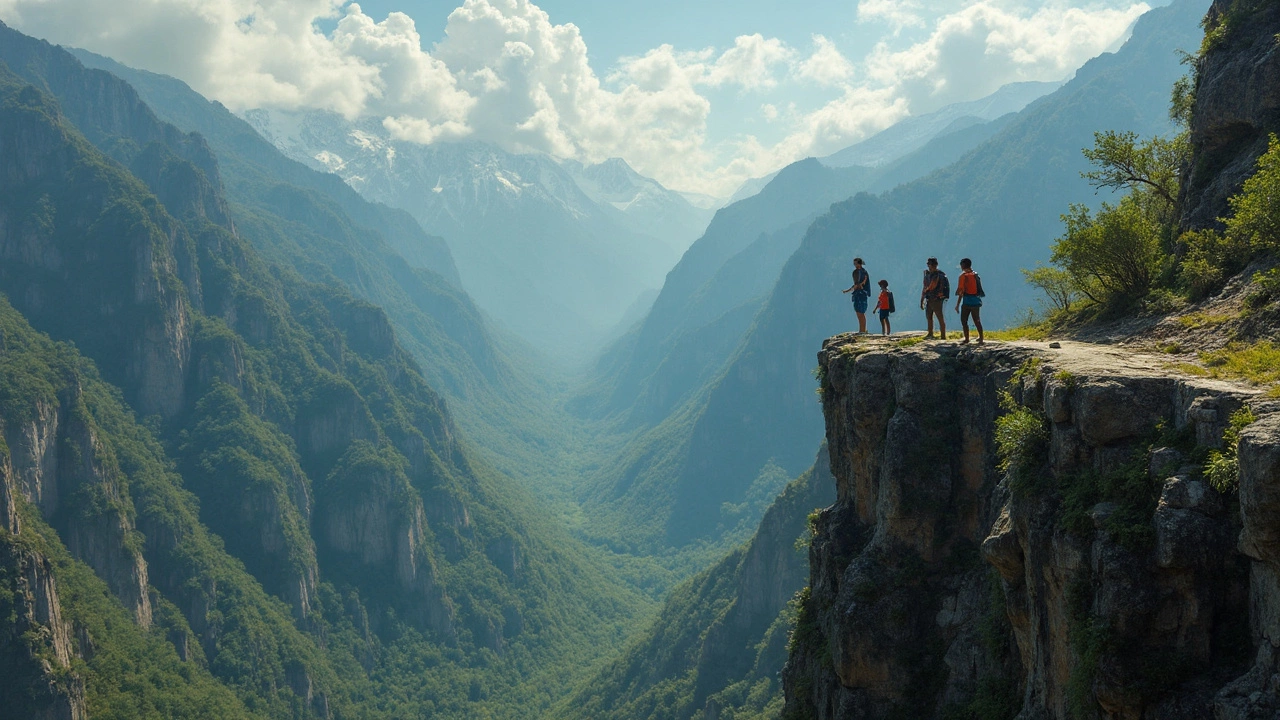
Why Paragliding Turns Heads
There’s something about paragliding that just grabs people. Maybe it’s the idea of flying over valleys and mountain slopes with nothing but fabric, ropes, and wind keeping you up. India’s gotten crazy about this sport in the last decade, especially spots like Bir Billing in Himachal Pradesh, which is now rated among the top paragliding destinations in the world. In fact, Bir Billing even hosted the Paragliding World Cup in 2015, bringing global attention straight to India’s hills.
Here’s why paragliding stands out from other adventure sports India offers:
- It’s open to almost everyone—kids and adults. As long as you’re relatively healthy and not terrified of heights, you’re good to go.
- No hardcore fitness required. Tandem flights mean a pro handles takeoff and landing. You just need to run at the start.
- Flights can last from 15 minutes up to 90 minutes, depending on wind and weather. No two flights feel the same.
- The view is unbeatable. Seriously, you’ll see more hills, forests, or fields in half an hour than you’d hike in a day.
And it’s not just fun. Paragliding brings in real results for local communities too. Towns like Bir, Kamshet (near Pune), and Nandi Hills (just outside Bangalore) rely on paragliding tourism. Every year, thousands of flyers boost local economies through bookings, gear rentals, and food stops.
Check these numbers out for Bir Billing (2019-2024):
| Year | Pilots Registered | Estimated Tourist Flights |
|---|---|---|
| 2019 | 390 | 13,200 |
| 2020 | 102 | 3,500 |
| 2021 | 445 | 17,650 |
| 2022 | 470 | 21,000 |
| 2023 | 515 | 23,600 |
So what do you need to keep in mind before signing up for your first real flight? A licensed instructor, basic fitness, and checking weather conditions matter a lot. Early mornings are usually safest—winds are cooler and more predictable.
If you’re ready for the open sky, adventure sports India has your back. You’ll find certified schools, easy-to-book rides, and guides who know the mountains like the back of their hand. Just don’t skip the helmet selfie afterward—you’ll want proof you actually did it.
Beyond the Usual: Unheard-of Thrills
If you thought you’d seen it all with trekking or river rafting, wait till you hear about India’s lesser-known wild rides. These aren’t just sideshows—they’re the stuff hardcore stories are made of. A few are only possible in certain pockets of the country, making them feel exclusive and totally worth bragging about.
One wild example is bungee jumping off India’s highest point at Rishikesh—83 meters of pure drop. It’s not just the height that freaks out newcomers but the silence before the fall. This spot even follows international safety standards, so it’s more legit than you’d guess for something that feels this crazy.
Ever tried caving? Meghalaya is famous for its natural limestone caves, some stretching for over 20 kilometers, like the Krem Liat Prah cave. If you’re not afraid of tight, dark spaces, this one lets you wander under the earth, squeezing, climbing, and spider-walking through ancient rock formations. It’s sweaty, muddy, and totally different from above-ground trails.
Motorbiking through the frozen Zanskar river, known as the Chadar Trek in Ladakh, takes the idea of adventure a step further. Extreme cold, shifting ice, and zero backup if something goes wrong—these aren’t just hiking headaches. Every winter, only a small window opens for this route, so timing is everything.
If heights are your thing, skydiving in Mysore and Dhana has picked up fast. Imagine the view—a full drop from 10,000 feet, seeing the ground race up to meet you. These jumps use tandem systems for beginners, so you can get the thrill with minimum training but max safety.
- Always double-check safety gear and guides for these activities—well-rated operators will have solid reviews and clear safety standards.
- Book in the right season. Biking and skydiving are weather-sensitive; winter treks have tiny time slots.
- If you want an unusual story, talk to locals. Some secrets—like hidden bouldering spots in Hampi—don’t show up in tourist guides.
So if you’re looking to level up from mainstream adventures, these unheard-of experiences across India put the adventure sports India scene on a whole other playing field.
Tips to Stay Safe and Amp Up the Fun
No thrill is worth it if you end up hurt or don’t enjoy the ride. Here’s how to make sure your next adventure sports India experience is both safe and full of real excitement.
- Don’t ignore the briefing: Even veteran adventurers admit that most accidents happen when basics are skipped. Listen to your instructor, no matter how many times you’ve done the sport.
- Wear the right gear: It’s not just about looking the part. Helmets, harnesses, life jackets—these aren’t optional. In Himachal Pradesh, local regulations made helmets and certified operators a must for paragliding, and accident rates dropped by 40% in two years.
- Stay honest with yourself: Don’t overestimate your fitness or courage. That’s usually what lands people in trouble. If you’re not strong at swimming, maybe skip the highest grade rapids and go for the moderate ones first.
- Respect local weather reports: Monsoon river rafting is tempting, but trusted guides in Rishikesh flat-out refuse trips during heavy rain. That’s because the Ganga can turn deadly fast.
- Book with certified operators: India has its share of unlicensed adventure businesses. Always check for government certification, reviews, and safety track record.
- Keep emergency contacts handy: Whether in the mountains or on the river, quick access to help can make all the difference.
If you ever doubt safety advice sounds exaggerated, consider this from Major (Retd.) Vivek Vohra, an expert in Himalayan expeditions:
“No adventure is worth risking your life for. The best stories come from those who prepare, not those who gamble.”
Here’s a glimpse of why prep matters:
| Adventure Sport | Major Incident Rate (per 1,000) | Mandatory Gear |
|---|---|---|
| White Water Rafting | 2.1 | Life Jacket, Helmet |
| Paragliding | 1.5 | Helmet, Harness |
| Rock Climbing | 3.4 | Helmet, Harness, Rope |
Shortcuts usually backfire, and local guides know things you can’t Google. Take their advice, gear up right, and you’ll leave with stories—and all your limbs intact. Most importantly, focus on soaking up the fun. If you’re too anxious, you miss out on the whole reason you’re out there: living the moment.
